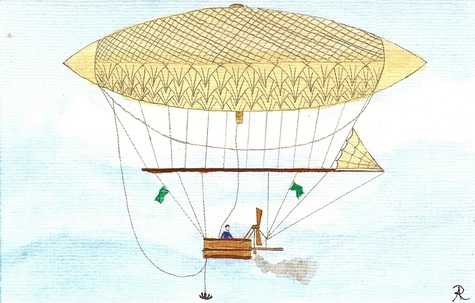Heights were never my forte. I'm really tiny and not a big fan or airplanes or bungee jumps, though I've experienced both. However, I adore Zeppelins (the band too, but the aircrafts more). They bring me that cool and comfy nostalgic feeling - except whenever I read about Hindenburg - and I wish I could fly in one of them. So, today, I'll write a little about their history!
The first Zeppelin was created in 1852 in France, by the steam technician Henri Giffard. It had 43m length, was propelled by a 3 hp steam engine that triggered a helix of 3,5m diameter. It reached the speed of 8km/h and flew about 25km before landing. Later, engineers noticed that, to become more functional, Zeppelins needed gasolin engines and a light aluminum alloy, which were developed in the 1880 decade. It was also understood that the power of elevation of the machine, which depended on the gas volume, would be improved if its length dimensions were increased.
Gathering all these elements, the count Ferdinand von Zeppelin (were the popular name comes from) built his flying machine. The prototype, completed in 1900, was a cilinder of 128m with an aluminon frame coated with a cotton web. It could put up 11.320 cubic meters of hidrogen in 17 leakproof bags and was moved by two Daimler engines of 14 hp.
During the first World War, Zeppelins were used in the first airstrikes in History, dropping bombs over London. Airship travels were in fashion in 30's - small groups of privileged people were taken from capital to capital and even across the Atlantic! The Zeppelin models back then exceeded 240m length. Sadly, when accidents happened, they tended to have great proportions, usually killing all passengers and crew.
The first Zeppelin was created in 1852 in France, by the steam technician Henri Giffard. It had 43m length, was propelled by a 3 hp steam engine that triggered a helix of 3,5m diameter. It reached the speed of 8km/h and flew about 25km before landing. Later, engineers noticed that, to become more functional, Zeppelins needed gasolin engines and a light aluminum alloy, which were developed in the 1880 decade. It was also understood that the power of elevation of the machine, which depended on the gas volume, would be improved if its length dimensions were increased.
Gathering all these elements, the count Ferdinand von Zeppelin (were the popular name comes from) built his flying machine. The prototype, completed in 1900, was a cilinder of 128m with an aluminon frame coated with a cotton web. It could put up 11.320 cubic meters of hidrogen in 17 leakproof bags and was moved by two Daimler engines of 14 hp.
During the first World War, Zeppelins were used in the first airstrikes in History, dropping bombs over London. Airship travels were in fashion in 30's - small groups of privileged people were taken from capital to capital and even across the Atlantic! The Zeppelin models back then exceeded 240m length. Sadly, when accidents happened, they tended to have great proportions, usually killing all passengers and crew.
~Ally

 RSS Feed
RSS Feed